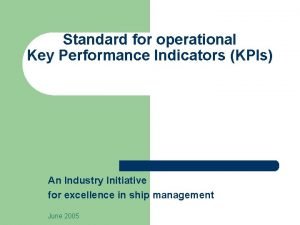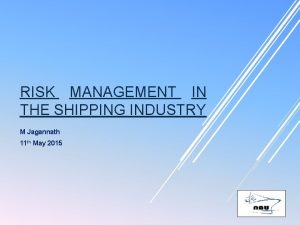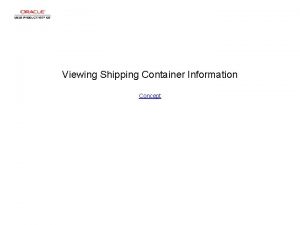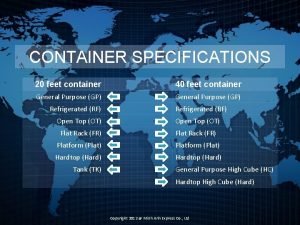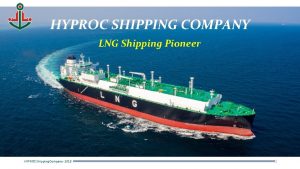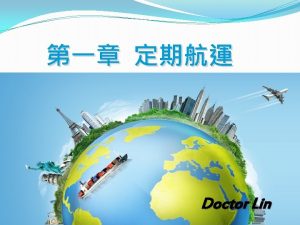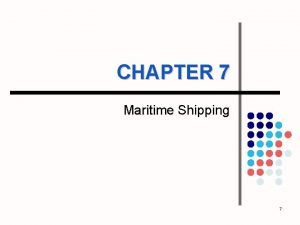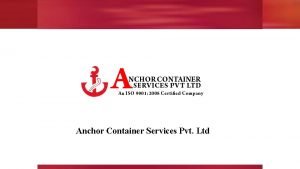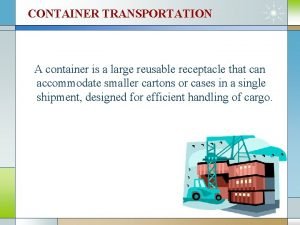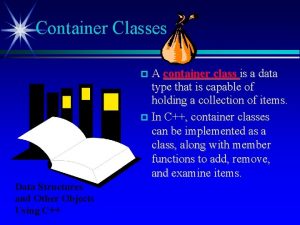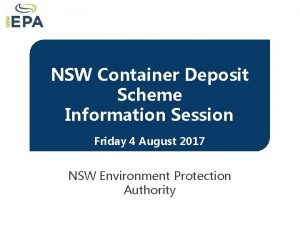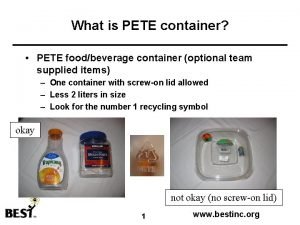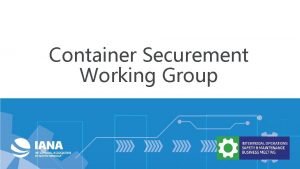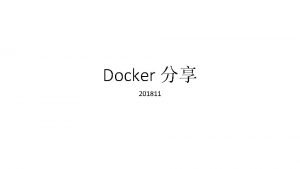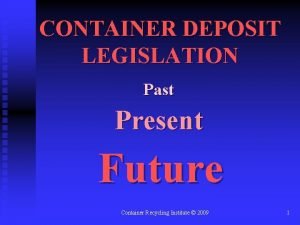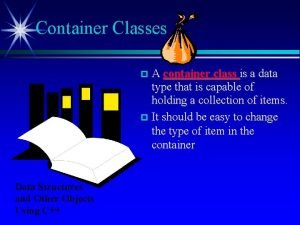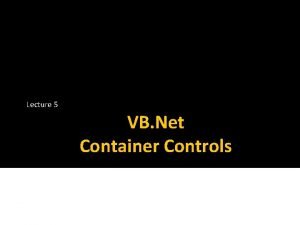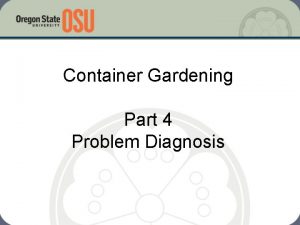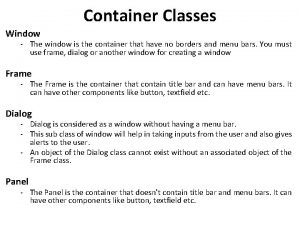Container shipping industry Introduction to Shipping Industry the










































- Slides: 42

Container shipping industry

Introduction to Shipping Industry, the industry devoted to moving goods or passengers by water. Passenger operations have been a major component of shipping, but air travel has seriously limited this aspect of the industry. The enormous increase, however, in certain kinds of cargo, for example, petroleum, has more than made up for the loss of passenger traffic.

Introduction to Shipping Although raw materials such as mineral ores, coal, lumber, grain, and other foodstuffs supply a vast and still growing volume of cargo, the transportation of manufactured goods has increased rapidly since World War II.

The importance of shipping § International shipping carries 90% of the world’s trade. It is the lynchpin of the world economy. § Ships are large valuable assets of a sophisticated kind. Larger vessels can cost over USD 100 m to build. § World freight is an estimated USD 380 billion per annum.

About India § India is an emerging global economy § Good Industrial growth. § Robust macroeconomic fundamentals. § Worlds largest democracy. § Growing Market for Investors

About India § India has a coastline of 7517 Kms §Is located in the International route between East and West §Thus it has an advantage and is developing into a major Maritime nation

PLAYERS IN THE CONTAINER SUPPLY CHAIN CARGO SHIPS FREIGHT TRAINS INLAND CONTAINER DEPOT TRUCKS


Containerization is a systematic storage by using standards that are standardized by the International Standardization Organization. Container capacity of Ships, Yards , Terminals are measured in TEU =

• ‘Article Equipment intended to facilitate the carriage of goods by one or more modes of transport without intermediate reloading'. • Containerization is a system of intermodal freight transport using standard inter modal containers as prescribed by ISO. • These can be loaded and sealed intact onto container ships, rail road cards, planes, and trucks 10

• Although having its origins in the late 1780 • Innovations in 20 th century logistics. • Malcom Purcell Mc. Lean(November 14, 1913 – May 25, 2001 )was an American entrepreneur, often called "the father of containerization". • In 1956, he developed the metal shipping container, which replaced the traditional break-bulk method of handling dry goods and revolutionized the transport of goods and cargo worldwide 11

TYPES OF CONTAINER • Dry storage container • Flat rack container • Open top container • Tunnel container • Open side storage container • Double doors container • Refrigerated ISO containers • Insulated or thermal containers

CONT……. . • Tanks • Cargo storage roll container • Half height containers • Car carriers • Intermediate bulk shift containers • Drums • Special purpose containers • Swap bodies

STANDARD CONTAINERS Standard 20' inside length inside width inside height door width door height capacity tare weight maxi cargo 19'4" 7'8" 7'10" 7'8" 7'6" 1, 172 Cu. Ft 4, 916 lbs 47, 900 lbs 5. 900 m 2. 350 m 2. 393 m 2. 342 m 2. 280 m 33. 2 CBM 2, 230 Kg 21, 770 Kg inside length inside width inside height door width door height capacity tare weight maxi cargo 39'5" 7'8" 7'10" 7'8" 7'6" 2, 390 Cu. Ft 8, 160 lbs 59, 040 lbs 12. 036 m 2. 350 m 2. 392 m 2. 340 m 2. 280 m 67. 7 CBM 3, 700 Kg 14 26, 780 Kg Standard 40'

OPEN TOP CONTAINERS Opentop 20' inside length inside width inside height door width door height capacity tare weight maxi cargo 19'4" 7'7" 7'8" 7'6" 7'2" 1, 136 Cu. Ft 5, 280 lbs 47, 620 lbs 5. 894 m 2. 311 m 2. 354 m 2. 286 m 2. 184 m 32. 23 CBM 2, 400 Kg 21, 600 Kg inside length inside width inside height door width door height capacity tare weight maxi cargo 39'5" 7'8" 7'5" 2, 350 Cu. Ft 8, 490 lbs 58, 710 lbs 12. 028 m 2. 350 m 2. 345 m 2. 341 m 2. 274 m 65. 5 CBM 3, 850 Kg 15 26, 630 Kg Opentop 40'

FLATRACK CONTAINERS: Flatrack 20' inside length inside width inside height door width door height capacity tare weight maxi cargo 18'5" 7'3" 7'4" - - - 5, 578 lbs 47, 333 lbs 5. 620 m 2. 200 m 2. 233 m - - - 2, 530 Kg 21, 470 Kg inside length inside width inside height door width door height capacity tare weight maxi cargo 39'7" 6'10" 6'5" - - - 12, 081 lbs 85, 800 lbs 12. 080 m 2. 438 m 2. 103 m - - - 5, 480 Kg 16 39, 000 Kg Flatrack 40'

FLATRACK COLLAPSIBLE CONTAINERS: Flatrack Collapsible 20' inside length inside width inside height door width door height capacity tare weight maxi cargo 18'6" 7'3" 7'4" - - - 6, 061 lbs 61, 117 lbs 5. 618 m 2. 208 m 2. 233 m - - - 2, 750 Kg 17, 730 Kg Flatrack Collapsible 40' inside length inside width inside height door width door height capacity tare weight maxi cargo 39'7" 6'10" 6'5" - - - 12, 081 lbs 85, 800 lbs 12. 080 m 2. 126 m 2. 043 m - - - 5, 800 Kg 17 39, 000 Kg

REEFER CONTAINERS Reefer 20' inside length inside width inside height door width door height capacity tare weight maxi cargo 17'8" 7'5" 7'3" 1, 000 Cu. Ft 7, 040 lbs 45, 760 lbs 5. 425 m 2. 275 m 2. 260 m 2. 258 m 2. 216 m 28. 3 CBM 3, 200 Kg 20, 800 Kg inside length inside width inside height door width door height capacity tare weight maxi cargo 37'8" 7'5" 7'2" 7'5" 7'0" 2, 040 Cu. Ft 10, 780 lbs 56, 276 lbs 11. 493 m 2. 270 m 2. 197 m 2. 282 m 2. 155 m 57. 8 CBM 4, 900 Kg 25, 580 Kg Reefer 40' Reefer High Cube 40' inside length inside width inside height door width door height capacity tare weight maxi cargo 37'11" 7'6" 8'2" 7'6" 8'0" 2, 344 Cu. Ft 9, 900 lbs 57, 761 lbs 11. 557 m 2. 294 m 2. 500 m 2. 294 m 2. 440 m 66. 6 CBM 4, 500 Kg 25, 980 Kg 18

HIGHCUBE CONTAINERS HIGH CUBE 45' inside length inside width inside height door width door height capacity tare weight maxi cargo 39'5" 7'8" 8'10" 7'8" 8'5" 2, 694 Cu. Ft 8, 750 lbs 58, 450 lbs 12. 036 m 2. 350 m 2. 697 m 2. 338 m 76. 3 CBM 3, 970 Kg 26, 510 Kg 19

PLATFORM CONTAINERS PLATFORM 20' inside length inside width inside height door width door height capacity tare weight maxi cargo 19'11" 8'0" 7'4" - - - 6, 061 lbs 52, 896 lbs 6. 058 m 2. 438 m 2. 233 m - - - 2, 750 Kg 24, 000 Kg inside length inside width inside height door width door height capacity tare weight maxi cargo 40'0" 8'0" 6'5" - - - 12, 783 lbs 86, 397 lbs 12. 180 m 2. 400 m 1. 950 m - - - 5, 800 Kg 39, 200 Kg 20 PLATFORM 40'

PICTORIAL FLOWCHART Shipper books shipment with WHL advises port depot to release empty to Shipper At Shipper’s premises shipment stuffed into Contr. Stuffed laden box returned to port by Shipper Port depot releases empty to Shipper Released empty is taken to Shipper’s premises Stuffed laden box upon return to port is stacked in CY laden box is loaded to vsl Ship sails out with the shipment At Shipper’s premises shipment stuffed into Contr. laden box taken to vsl side for loading

22

FACTOR ADVANTAGE Standard transport Can be manipulated anywhere in the world (ISO standard). Specialized ships, trucks and wagons. product Flexibility of usage Management Costs Warehousing Security Raw materials (coal, wheat), manufactured goods, cars, frozen products. Liquids (oil and chemical products) and �reefers�(50% of all refrigerated cargo). Reuse of discarded containers. Unique identification number and a size type code. Transport management not in terms of loads, but in terms of unit. Low transport costs; 20 times less than bulk transport. Transshipment operations are minimal and rapid. Port turnaround times reduced from 3 weeks to about 24 hours. Containerships are faster than regular freighter ships. Its own warehouse; Simpler and less expensive packaging. Stacking capacity on ships, trains (doublestacking) and on the ground. Contents of the container is unknown to shippers. Can only be opened at the origin, at customs and at the destination. 23 Reduced spoilage and losses (theft).

24

FACTOR CHALLENGE Site constraints Large consumption of terminal space; move to urban periphery. Draft issues with larger containerships. Infrastructure costs Container handling infrastructures (giant cranes, warehousing facilities, inland road, rail access), are important investments. Stacking Complexity of arrangement of containers, both on the ground and on modes (containerships and double-stack trains). Loaded to avoid any restacking. Management logistics Requires management and tracking of every container. Recording, (re)positioning and ordering of containers. Empty movements Many containers are moved empty (20% of all flows). Either full or empty, a container takes the same amount of space. Divergence between production and consumption; repositioning. Illicit trade Common instrument used in the illicit trade of drug and weapons, as well as for illegal immigration. Worries about the usage of containers for terrorism.

26

27

28

29

• Containerization was introduced for the first time in Indian domestic market way back in 1966 • In 1987 Government of India realized the importance of containerization and started constructing a satellite port at Bombay which commenced operations in 1988 and was christened The Jawaharlal Lal Nehru Port. 30

• First container was handled at Cochin in 1973. • Containerization has since grown substantially. • 1052000 TEUS in 1993. • 4637000 TEUS in 2005. • 6. 60 Million TEUS in 2008 • Currently around 8 million TEUS. . 31

Key players

vessels

Container Shipping World fleet, Feb 2004: 3167 vessels, capacity = 6. 5 million 20 -ft conts. (TEU) World fleet, Dec 2008: 4661 vessels, capacity = 12. 1 million 20 -ft conts. (TEU)

Container Shipping


Land-Scarce Container Terminals Cargo stacked up to 7 tiers high in large “blocks” 0 -3 truck traffic lanes between blocks Storage density: 1000 -1200 TEU per hectare Manually operated trucks and cranes No on-dock rail yard Port of singapore Cargo throughput: 2000 -2500 TEU per meter of wharf line per year

Land-Scarce Container Terminals Port of hong kong

Straddle Carrier-Based Container Terminals • Common on U. S. East Coast and in Europe • Cargo stacked 3 tiers high in “lanes” that are 1 container wide • Spaces between lanes very narrow • Storage density: 750 TEU per hectare • Manually operated straddle carriers perform operations 2 and 3 • On-dock rail yard a possibility: RMGCs may be needed • Cargo throughput: 1500 TEU per meter of wharf line per year Straddle carriers (SCs) Port of Hamburg

Wheel-Based Container Terminals • Common on U. S. West Coast • Loaded containers sitting on trailers (chassies) parked in storage yard (stacking height = 1 tier) • Empty containers stacked up to 4 tiers high by “side-picks” • Storage density: 250 TEU per hectare • Manually operated equipment • On-dock rail yard a possibility • Cargo throughput: 500 TEU per meter of wharf line per year Quay cranes (QCs

Automated Container Terminals II • Patrick Terminal at Port of Brisbane • Only automated SC-based terminal in the world • Cargo stacked 2 tiers high in “lanes” • Automated straddle carriers perform operations 2 and 3 Patrick Terminal (Brisbane, Australia)

Railway Container Transportation
 Stationary container system diagram
Stationary container system diagram Tramp trade software
Tramp trade software Key performance indicators for shipping industry
Key performance indicators for shipping industry Risk management in shipping industry
Risk management in shipping industry Hát kết hợp bộ gõ cơ thể
Hát kết hợp bộ gõ cơ thể Ng-html
Ng-html Bổ thể
Bổ thể Tỉ lệ cơ thể trẻ em
Tỉ lệ cơ thể trẻ em Gấu đi như thế nào
Gấu đi như thế nào Chụp tư thế worms-breton
Chụp tư thế worms-breton Hát lên người ơi alleluia
Hát lên người ơi alleluia Môn thể thao bắt đầu bằng chữ đua
Môn thể thao bắt đầu bằng chữ đua Thế nào là hệ số cao nhất
Thế nào là hệ số cao nhất Các châu lục và đại dương trên thế giới
Các châu lục và đại dương trên thế giới Công thức tiính động năng
Công thức tiính động năng Trời xanh đây là của chúng ta thể thơ
Trời xanh đây là của chúng ta thể thơ Mật thư anh em như thể tay chân
Mật thư anh em như thể tay chân Làm thế nào để 102-1=99
Làm thế nào để 102-1=99 Phản ứng thế ankan
Phản ứng thế ankan Các châu lục và đại dương trên thế giới
Các châu lục và đại dương trên thế giới Thể thơ truyền thống
Thể thơ truyền thống Quá trình desamine hóa có thể tạo ra
Quá trình desamine hóa có thể tạo ra Một số thể thơ truyền thống
Một số thể thơ truyền thống Cái miệng nó xinh thế
Cái miệng nó xinh thế Vẽ hình chiếu vuông góc của vật thể sau
Vẽ hình chiếu vuông góc của vật thể sau Thế nào là sự mỏi cơ
Thế nào là sự mỏi cơ đặc điểm cơ thể của người tối cổ
đặc điểm cơ thể của người tối cổ Giọng cùng tên là
Giọng cùng tên là Vẽ hình chiếu đứng bằng cạnh của vật thể
Vẽ hình chiếu đứng bằng cạnh của vật thể Tia chieu sa te
Tia chieu sa te Thẻ vin
Thẻ vin đại từ thay thế
đại từ thay thế điện thế nghỉ
điện thế nghỉ Tư thế ngồi viết
Tư thế ngồi viết Diễn thế sinh thái là
Diễn thế sinh thái là Các loại đột biến cấu trúc nhiễm sắc thể
Các loại đột biến cấu trúc nhiễm sắc thể Các số nguyên tố là gì
Các số nguyên tố là gì Tư thế ngồi viết
Tư thế ngồi viết Lời thề hippocrates
Lời thề hippocrates Thiếu nhi thế giới liên hoan
Thiếu nhi thế giới liên hoan ưu thế lai là gì
ưu thế lai là gì Sự nuôi và dạy con của hươu
Sự nuôi và dạy con của hươu Sự nuôi và dạy con của hươu
Sự nuôi và dạy con của hươu


